Project: Improving Unilever's HRM through Recruitment and Training
VerifiedAdded on 2021/02/19
|26
|5255
|25
Project
AI Summary
This project analyzes Unilever's Human Resource Management (HRM) practices, focusing on recruitment, selection, and training in the context of international requirements. The project begins with an introduction to Unilever and globalization, followed by the formulation of project aims, objectives, and research questions. A project management plan is developed, covering aspects like cost, scope, time, quality, communication, risk, and resources. A work breakdown structure and Gantt chart are created to outline project timelines and stages. The research involves qualitative and quantitative methods, including data collection through questionnaires. The collected data is then analyzed using appropriate tools and techniques to draw valid conclusions and recommendations. The project concludes with a reflection on the value of the research and its contribution to the stated objectives and learning outcomes.
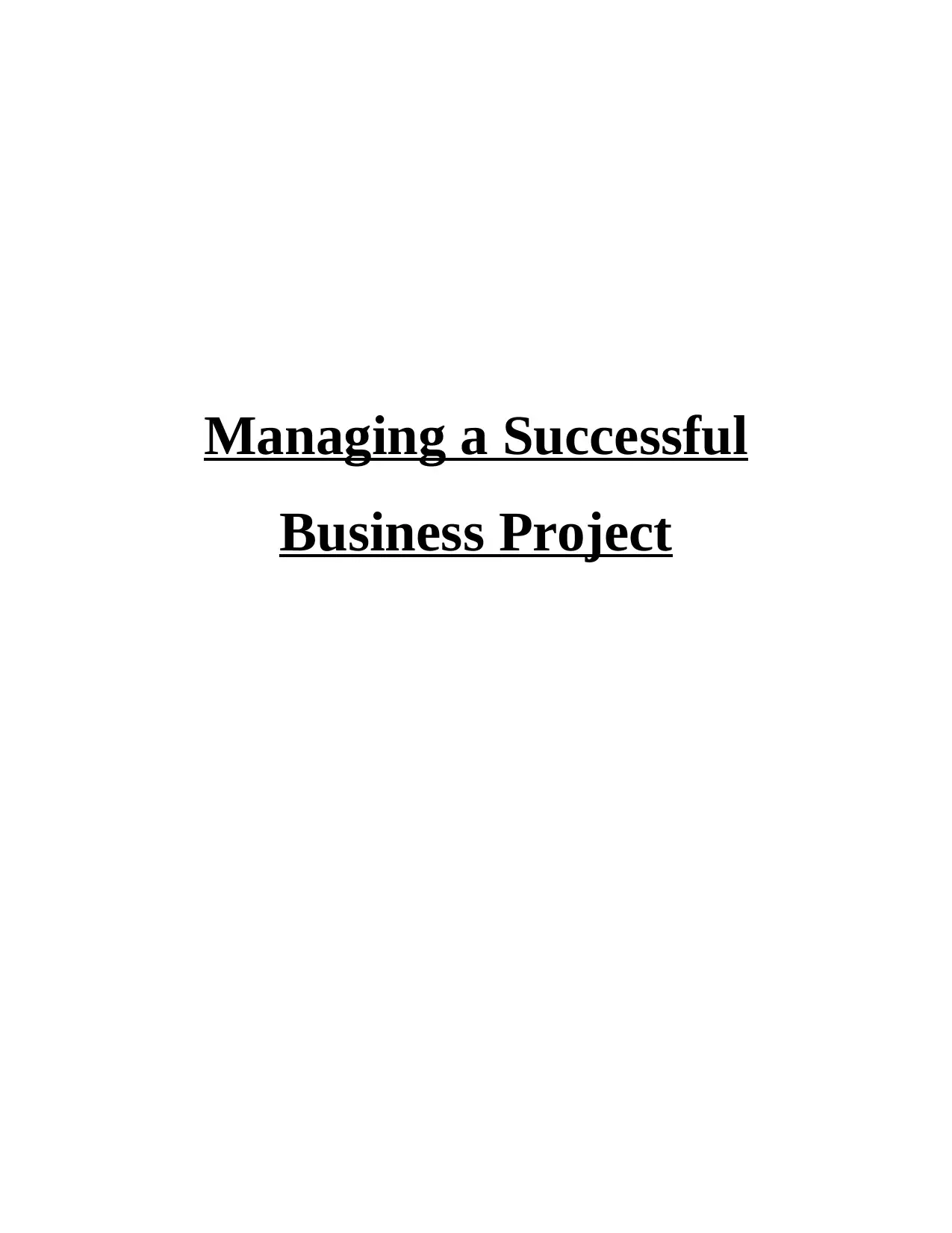
Managing a Successful
Business Project
Business Project
Paraphrase This Document
Need a fresh take? Get an instant paraphrase of this document with our AI Paraphraser
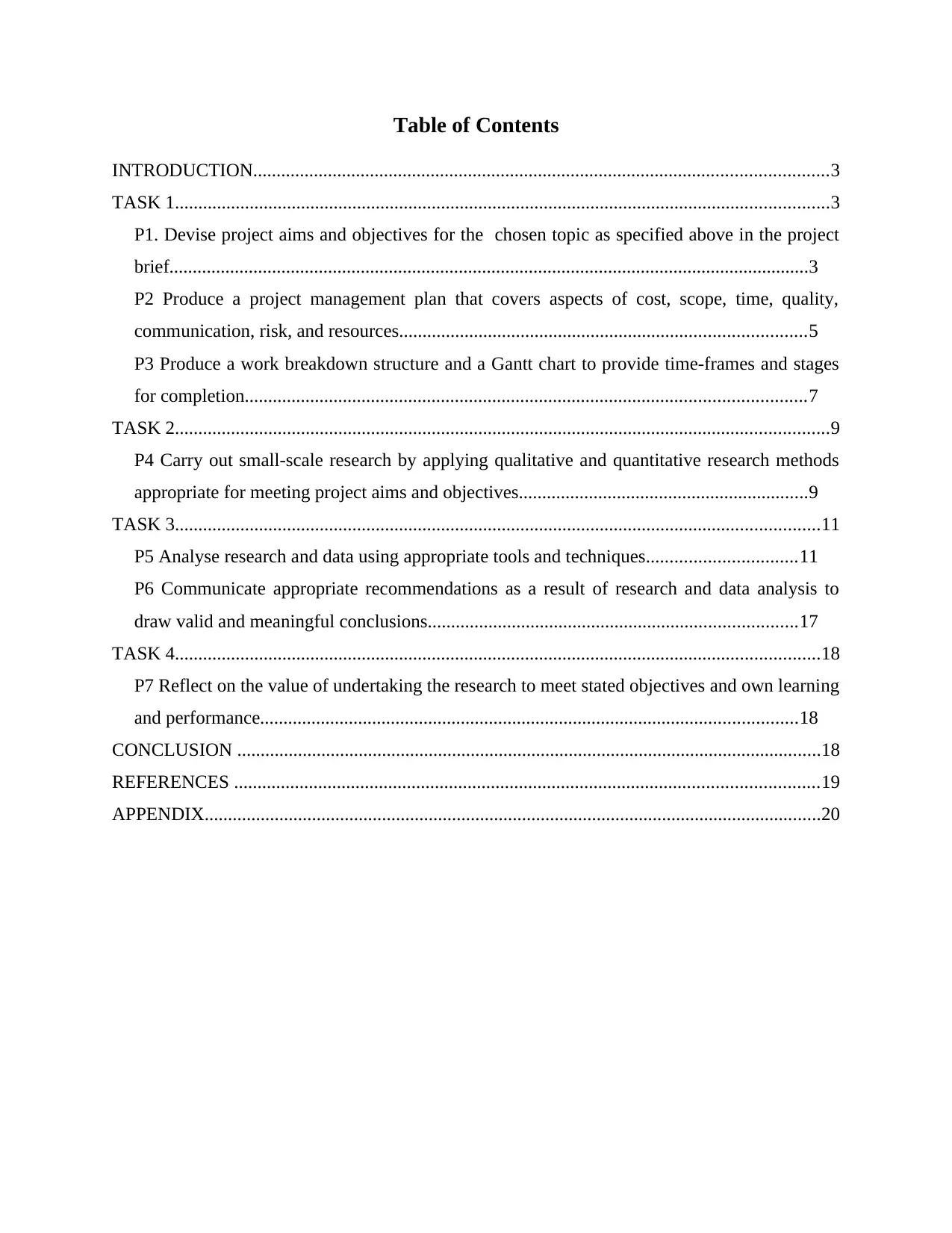
Table of Contents
INTRODUCTION...........................................................................................................................3
TASK 1............................................................................................................................................3
P1. Devise project aims and objectives for the chosen topic as specified above in the project
brief.........................................................................................................................................3
P2 Produce a project management plan that covers aspects of cost, scope, time, quality,
communication, risk, and resources.......................................................................................5
P3 Produce a work breakdown structure and a Gantt chart to provide time-frames and stages
for completion........................................................................................................................7
TASK 2............................................................................................................................................9
P4 Carry out small-scale research by applying qualitative and quantitative research methods
appropriate for meeting project aims and objectives..............................................................9
TASK 3..........................................................................................................................................11
P5 Analyse research and data using appropriate tools and techniques................................11
P6 Communicate appropriate recommendations as a result of research and data analysis to
draw valid and meaningful conclusions...............................................................................17
TASK 4..........................................................................................................................................18
P7 Reflect on the value of undertaking the research to meet stated objectives and own learning
and performance...................................................................................................................18
CONCLUSION .............................................................................................................................18
REFERENCES .............................................................................................................................19
APPENDIX....................................................................................................................................20
INTRODUCTION...........................................................................................................................3
TASK 1............................................................................................................................................3
P1. Devise project aims and objectives for the chosen topic as specified above in the project
brief.........................................................................................................................................3
P2 Produce a project management plan that covers aspects of cost, scope, time, quality,
communication, risk, and resources.......................................................................................5
P3 Produce a work breakdown structure and a Gantt chart to provide time-frames and stages
for completion........................................................................................................................7
TASK 2............................................................................................................................................9
P4 Carry out small-scale research by applying qualitative and quantitative research methods
appropriate for meeting project aims and objectives..............................................................9
TASK 3..........................................................................................................................................11
P5 Analyse research and data using appropriate tools and techniques................................11
P6 Communicate appropriate recommendations as a result of research and data analysis to
draw valid and meaningful conclusions...............................................................................17
TASK 4..........................................................................................................................................18
P7 Reflect on the value of undertaking the research to meet stated objectives and own learning
and performance...................................................................................................................18
CONCLUSION .............................................................................................................................18
REFERENCES .............................................................................................................................19
APPENDIX....................................................................................................................................20
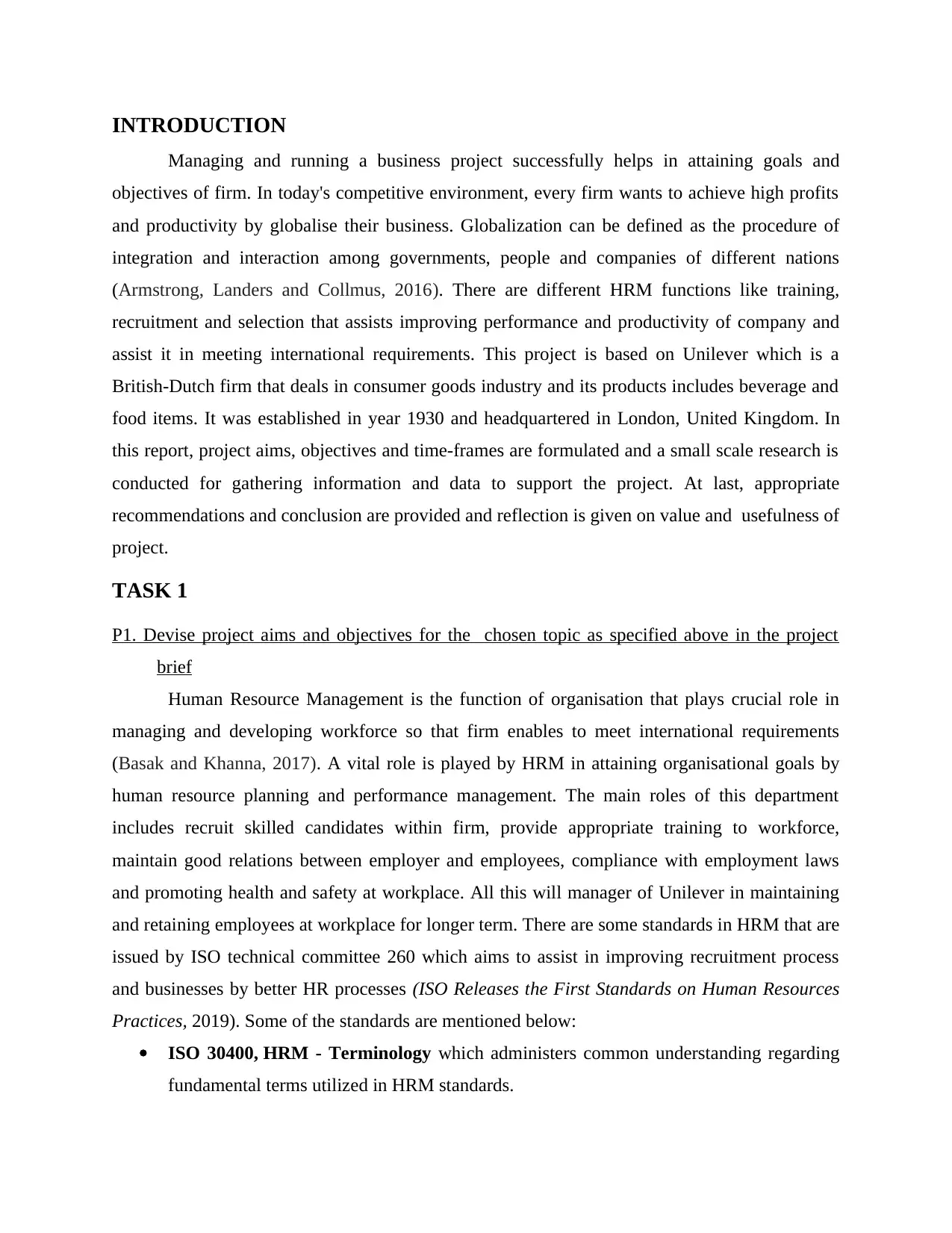
INTRODUCTION
Managing and running a business project successfully helps in attaining goals and
objectives of firm. In today's competitive environment, every firm wants to achieve high profits
and productivity by globalise their business. Globalization can be defined as the procedure of
integration and interaction among governments, people and companies of different nations
(Armstrong, Landers and Collmus, 2016). There are different HRM functions like training,
recruitment and selection that assists improving performance and productivity of company and
assist it in meeting international requirements. This project is based on Unilever which is a
British-Dutch firm that deals in consumer goods industry and its products includes beverage and
food items. It was established in year 1930 and headquartered in London, United Kingdom. In
this report, project aims, objectives and time-frames are formulated and a small scale research is
conducted for gathering information and data to support the project. At last, appropriate
recommendations and conclusion are provided and reflection is given on value and usefulness of
project.
TASK 1
P1. Devise project aims and objectives for the chosen topic as specified above in the project
brief
Human Resource Management is the function of organisation that plays crucial role in
managing and developing workforce so that firm enables to meet international requirements
(Basak and Khanna, 2017). A vital role is played by HRM in attaining organisational goals by
human resource planning and performance management. The main roles of this department
includes recruit skilled candidates within firm, provide appropriate training to workforce,
maintain good relations between employer and employees, compliance with employment laws
and promoting health and safety at workplace. All this will manager of Unilever in maintaining
and retaining employees at workplace for longer term. There are some standards in HRM that are
issued by ISO technical committee 260 which aims to assist in improving recruitment process
and businesses by better HR processes (ISO Releases the First Standards on Human Resources
Practices, 2019). Some of the standards are mentioned below:
ISO 30400, HRM - Terminology which administers common understanding regarding
fundamental terms utilized in HRM standards.
Managing and running a business project successfully helps in attaining goals and
objectives of firm. In today's competitive environment, every firm wants to achieve high profits
and productivity by globalise their business. Globalization can be defined as the procedure of
integration and interaction among governments, people and companies of different nations
(Armstrong, Landers and Collmus, 2016). There are different HRM functions like training,
recruitment and selection that assists improving performance and productivity of company and
assist it in meeting international requirements. This project is based on Unilever which is a
British-Dutch firm that deals in consumer goods industry and its products includes beverage and
food items. It was established in year 1930 and headquartered in London, United Kingdom. In
this report, project aims, objectives and time-frames are formulated and a small scale research is
conducted for gathering information and data to support the project. At last, appropriate
recommendations and conclusion are provided and reflection is given on value and usefulness of
project.
TASK 1
P1. Devise project aims and objectives for the chosen topic as specified above in the project
brief
Human Resource Management is the function of organisation that plays crucial role in
managing and developing workforce so that firm enables to meet international requirements
(Basak and Khanna, 2017). A vital role is played by HRM in attaining organisational goals by
human resource planning and performance management. The main roles of this department
includes recruit skilled candidates within firm, provide appropriate training to workforce,
maintain good relations between employer and employees, compliance with employment laws
and promoting health and safety at workplace. All this will manager of Unilever in maintaining
and retaining employees at workplace for longer term. There are some standards in HRM that are
issued by ISO technical committee 260 which aims to assist in improving recruitment process
and businesses by better HR processes (ISO Releases the First Standards on Human Resources
Practices, 2019). Some of the standards are mentioned below:
ISO 30400, HRM - Terminology which administers common understanding regarding
fundamental terms utilized in HRM standards.
⊘ This is a preview!⊘
Do you want full access?
Subscribe today to unlock all pages.

Trusted by 1+ million students worldwide
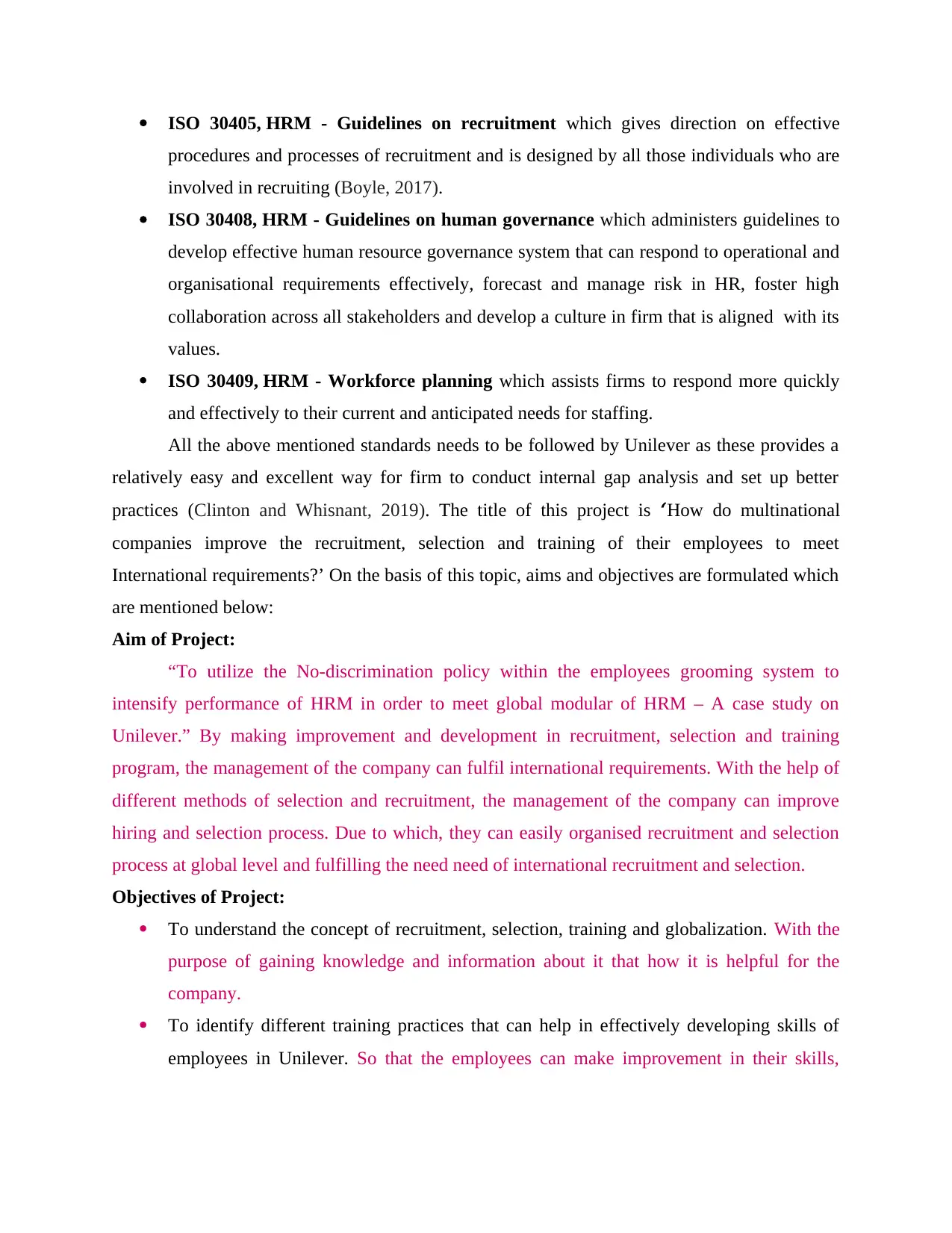
ISO 30405, HRM - Guidelines on recruitment which gives direction on effective
procedures and processes of recruitment and is designed by all those individuals who are
involved in recruiting (Boyle, 2017).
ISO 30408, HRM - Guidelines on human governance which administers guidelines to
develop effective human resource governance system that can respond to operational and
organisational requirements effectively, forecast and manage risk in HR, foster high
collaboration across all stakeholders and develop a culture in firm that is aligned with its
values.
ISO 30409, HRM - Workforce planning which assists firms to respond more quickly
and effectively to their current and anticipated needs for staffing.
All the above mentioned standards needs to be followed by Unilever as these provides a
relatively easy and excellent way for firm to conduct internal gap analysis and set up better
practices (Clinton and Whisnant, 2019). The title of this project is ‘How do multinational
companies improve the recruitment, selection and training of their employees to meet
International requirements?’ On the basis of this topic, aims and objectives are formulated which
are mentioned below:
Aim of Project:
“To utilize the No-discrimination policy within the employees grooming system to
intensify performance of HRM in order to meet global modular of HRM – A case study on
Unilever.” By making improvement and development in recruitment, selection and training
program, the management of the company can fulfil international requirements. With the help of
different methods of selection and recruitment, the management of the company can improve
hiring and selection process. Due to which, they can easily organised recruitment and selection
process at global level and fulfilling the need need of international recruitment and selection.
Objectives of Project:
To understand the concept of recruitment, selection, training and globalization. With the
purpose of gaining knowledge and information about it that how it is helpful for the
company.
To identify different training practices that can help in effectively developing skills of
employees in Unilever. So that the employees can make improvement in their skills,
procedures and processes of recruitment and is designed by all those individuals who are
involved in recruiting (Boyle, 2017).
ISO 30408, HRM - Guidelines on human governance which administers guidelines to
develop effective human resource governance system that can respond to operational and
organisational requirements effectively, forecast and manage risk in HR, foster high
collaboration across all stakeholders and develop a culture in firm that is aligned with its
values.
ISO 30409, HRM - Workforce planning which assists firms to respond more quickly
and effectively to their current and anticipated needs for staffing.
All the above mentioned standards needs to be followed by Unilever as these provides a
relatively easy and excellent way for firm to conduct internal gap analysis and set up better
practices (Clinton and Whisnant, 2019). The title of this project is ‘How do multinational
companies improve the recruitment, selection and training of their employees to meet
International requirements?’ On the basis of this topic, aims and objectives are formulated which
are mentioned below:
Aim of Project:
“To utilize the No-discrimination policy within the employees grooming system to
intensify performance of HRM in order to meet global modular of HRM – A case study on
Unilever.” By making improvement and development in recruitment, selection and training
program, the management of the company can fulfil international requirements. With the help of
different methods of selection and recruitment, the management of the company can improve
hiring and selection process. Due to which, they can easily organised recruitment and selection
process at global level and fulfilling the need need of international recruitment and selection.
Objectives of Project:
To understand the concept of recruitment, selection, training and globalization. With the
purpose of gaining knowledge and information about it that how it is helpful for the
company.
To identify different training practices that can help in effectively developing skills of
employees in Unilever. So that the employees can make improvement in their skills,
Paraphrase This Document
Need a fresh take? Get an instant paraphrase of this document with our AI Paraphraser
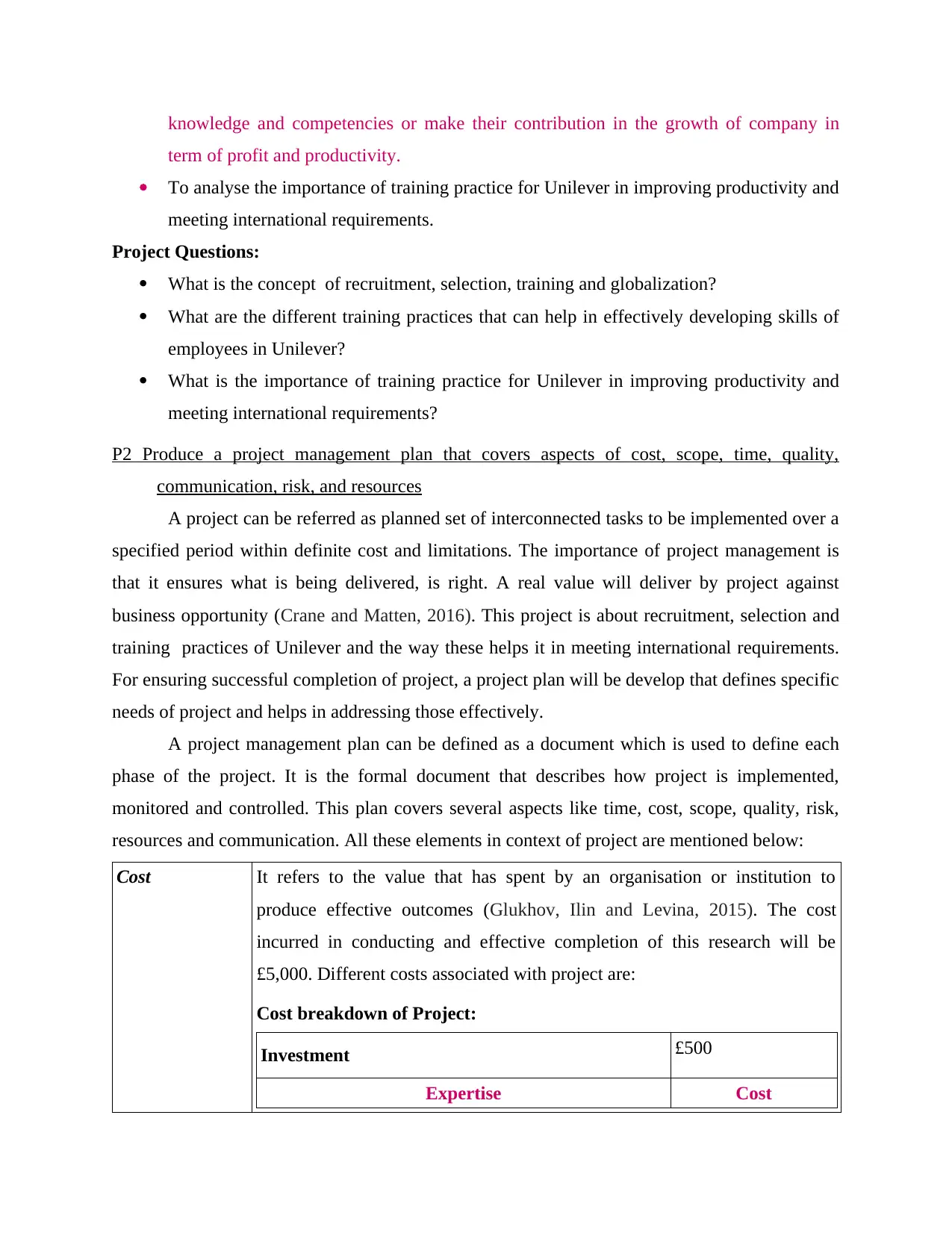
knowledge and competencies or make their contribution in the growth of company in
term of profit and productivity.
To analyse the importance of training practice for Unilever in improving productivity and
meeting international requirements.
Project Questions:
What is the concept of recruitment, selection, training and globalization?
What are the different training practices that can help in effectively developing skills of
employees in Unilever?
What is the importance of training practice for Unilever in improving productivity and
meeting international requirements?
P2 Produce a project management plan that covers aspects of cost, scope, time, quality,
communication, risk, and resources
A project can be referred as planned set of interconnected tasks to be implemented over a
specified period within definite cost and limitations. The importance of project management is
that it ensures what is being delivered, is right. A real value will deliver by project against
business opportunity (Crane and Matten, 2016). This project is about recruitment, selection and
training practices of Unilever and the way these helps it in meeting international requirements.
For ensuring successful completion of project, a project plan will be develop that defines specific
needs of project and helps in addressing those effectively.
A project management plan can be defined as a document which is used to define each
phase of the project. It is the formal document that describes how project is implemented,
monitored and controlled. This plan covers several aspects like time, cost, scope, quality, risk,
resources and communication. All these elements in context of project are mentioned below:
Cost It refers to the value that has spent by an organisation or institution to
produce effective outcomes (Glukhov, Ilin and Levina, 2015). The cost
incurred in conducting and effective completion of this research will be
£5,000. Different costs associated with project are:
Cost breakdown of Project:
Investment £500
Expertise Cost
term of profit and productivity.
To analyse the importance of training practice for Unilever in improving productivity and
meeting international requirements.
Project Questions:
What is the concept of recruitment, selection, training and globalization?
What are the different training practices that can help in effectively developing skills of
employees in Unilever?
What is the importance of training practice for Unilever in improving productivity and
meeting international requirements?
P2 Produce a project management plan that covers aspects of cost, scope, time, quality,
communication, risk, and resources
A project can be referred as planned set of interconnected tasks to be implemented over a
specified period within definite cost and limitations. The importance of project management is
that it ensures what is being delivered, is right. A real value will deliver by project against
business opportunity (Crane and Matten, 2016). This project is about recruitment, selection and
training practices of Unilever and the way these helps it in meeting international requirements.
For ensuring successful completion of project, a project plan will be develop that defines specific
needs of project and helps in addressing those effectively.
A project management plan can be defined as a document which is used to define each
phase of the project. It is the formal document that describes how project is implemented,
monitored and controlled. This plan covers several aspects like time, cost, scope, quality, risk,
resources and communication. All these elements in context of project are mentioned below:
Cost It refers to the value that has spent by an organisation or institution to
produce effective outcomes (Glukhov, Ilin and Levina, 2015). The cost
incurred in conducting and effective completion of this research will be
£5,000. Different costs associated with project are:
Cost breakdown of Project:
Investment £500
Expertise Cost
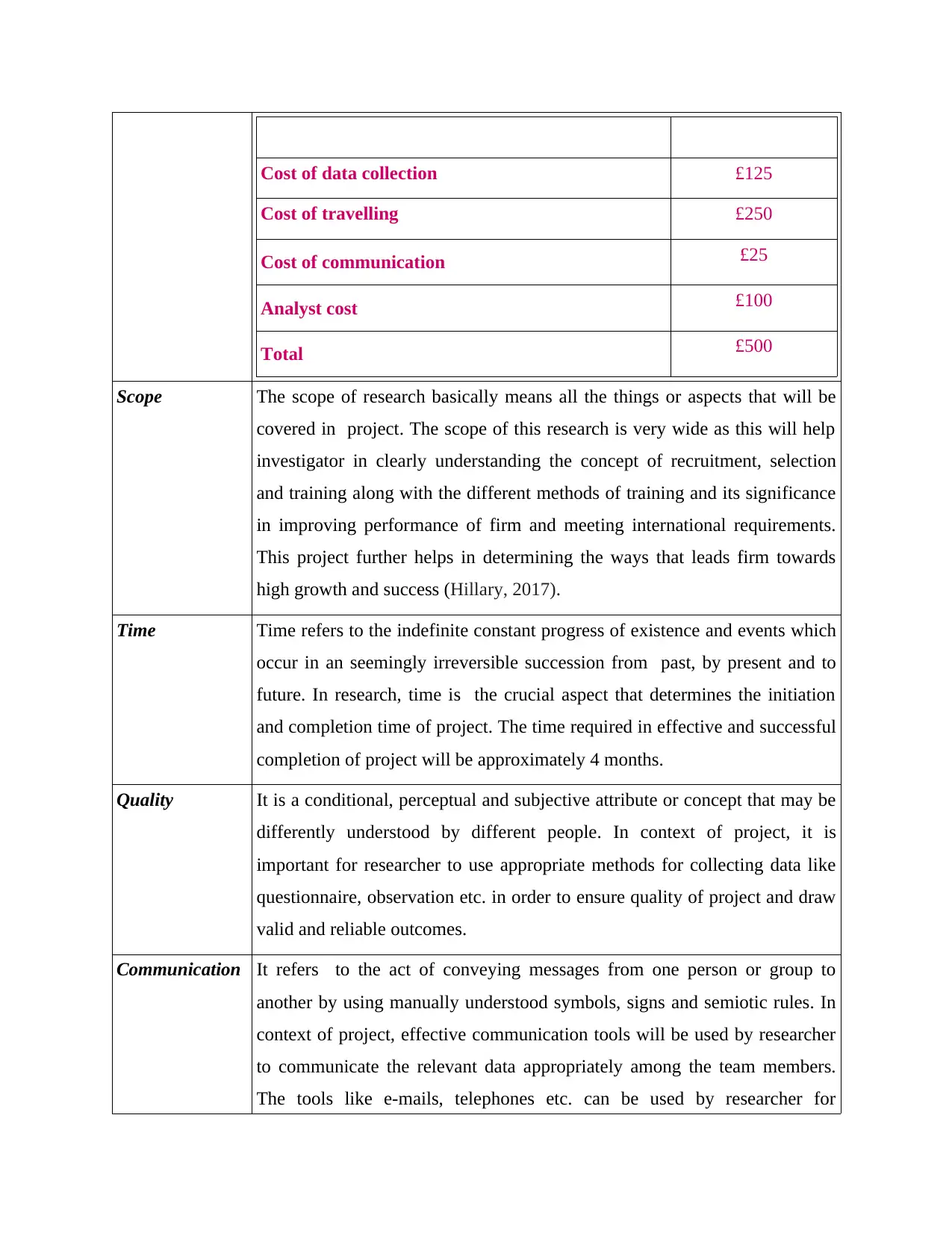
Cost of data collection £125
Cost of travelling £250
Cost of communication £25
Analyst cost £100
Total £500
Scope The scope of research basically means all the things or aspects that will be
covered in project. The scope of this research is very wide as this will help
investigator in clearly understanding the concept of recruitment, selection
and training along with the different methods of training and its significance
in improving performance of firm and meeting international requirements.
This project further helps in determining the ways that leads firm towards
high growth and success (Hillary, 2017).
Time Time refers to the indefinite constant progress of existence and events which
occur in an seemingly irreversible succession from past, by present and to
future. In research, time is the crucial aspect that determines the initiation
and completion time of project. The time required in effective and successful
completion of project will be approximately 4 months.
Quality It is a conditional, perceptual and subjective attribute or concept that may be
differently understood by different people. In context of project, it is
important for researcher to use appropriate methods for collecting data like
questionnaire, observation etc. in order to ensure quality of project and draw
valid and reliable outcomes.
Communication It refers to the act of conveying messages from one person or group to
another by using manually understood symbols, signs and semiotic rules. In
context of project, effective communication tools will be used by researcher
to communicate the relevant data appropriately among the team members.
The tools like e-mails, telephones etc. can be used by researcher for
Cost of travelling £250
Cost of communication £25
Analyst cost £100
Total £500
Scope The scope of research basically means all the things or aspects that will be
covered in project. The scope of this research is very wide as this will help
investigator in clearly understanding the concept of recruitment, selection
and training along with the different methods of training and its significance
in improving performance of firm and meeting international requirements.
This project further helps in determining the ways that leads firm towards
high growth and success (Hillary, 2017).
Time Time refers to the indefinite constant progress of existence and events which
occur in an seemingly irreversible succession from past, by present and to
future. In research, time is the crucial aspect that determines the initiation
and completion time of project. The time required in effective and successful
completion of project will be approximately 4 months.
Quality It is a conditional, perceptual and subjective attribute or concept that may be
differently understood by different people. In context of project, it is
important for researcher to use appropriate methods for collecting data like
questionnaire, observation etc. in order to ensure quality of project and draw
valid and reliable outcomes.
Communication It refers to the act of conveying messages from one person or group to
another by using manually understood symbols, signs and semiotic rules. In
context of project, effective communication tools will be used by researcher
to communicate the relevant data appropriately among the team members.
The tools like e-mails, telephones etc. can be used by researcher for
⊘ This is a preview!⊘
Do you want full access?
Subscribe today to unlock all pages.

Trusted by 1+ million students worldwide
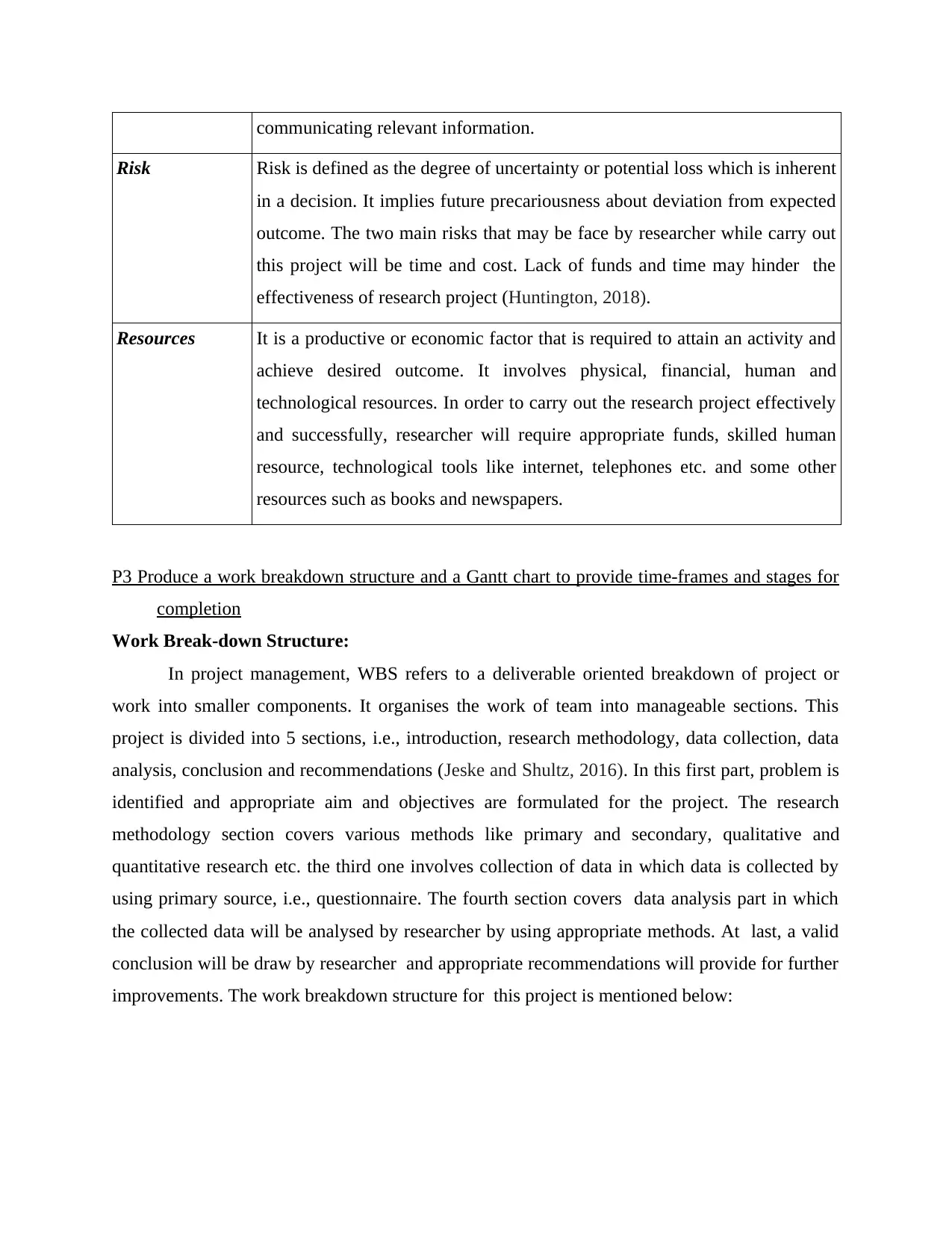
communicating relevant information.
Risk Risk is defined as the degree of uncertainty or potential loss which is inherent
in a decision. It implies future precariousness about deviation from expected
outcome. The two main risks that may be face by researcher while carry out
this project will be time and cost. Lack of funds and time may hinder the
effectiveness of research project (Huntington, 2018).
Resources It is a productive or economic factor that is required to attain an activity and
achieve desired outcome. It involves physical, financial, human and
technological resources. In order to carry out the research project effectively
and successfully, researcher will require appropriate funds, skilled human
resource, technological tools like internet, telephones etc. and some other
resources such as books and newspapers.
P3 Produce a work breakdown structure and a Gantt chart to provide time-frames and stages for
completion
Work Break-down Structure:
In project management, WBS refers to a deliverable oriented breakdown of project or
work into smaller components. It organises the work of team into manageable sections. This
project is divided into 5 sections, i.e., introduction, research methodology, data collection, data
analysis, conclusion and recommendations (Jeske and Shultz, 2016). In this first part, problem is
identified and appropriate aim and objectives are formulated for the project. The research
methodology section covers various methods like primary and secondary, qualitative and
quantitative research etc. the third one involves collection of data in which data is collected by
using primary source, i.e., questionnaire. The fourth section covers data analysis part in which
the collected data will be analysed by researcher by using appropriate methods. At last, a valid
conclusion will be draw by researcher and appropriate recommendations will provide for further
improvements. The work breakdown structure for this project is mentioned below:
Risk Risk is defined as the degree of uncertainty or potential loss which is inherent
in a decision. It implies future precariousness about deviation from expected
outcome. The two main risks that may be face by researcher while carry out
this project will be time and cost. Lack of funds and time may hinder the
effectiveness of research project (Huntington, 2018).
Resources It is a productive or economic factor that is required to attain an activity and
achieve desired outcome. It involves physical, financial, human and
technological resources. In order to carry out the research project effectively
and successfully, researcher will require appropriate funds, skilled human
resource, technological tools like internet, telephones etc. and some other
resources such as books and newspapers.
P3 Produce a work breakdown structure and a Gantt chart to provide time-frames and stages for
completion
Work Break-down Structure:
In project management, WBS refers to a deliverable oriented breakdown of project or
work into smaller components. It organises the work of team into manageable sections. This
project is divided into 5 sections, i.e., introduction, research methodology, data collection, data
analysis, conclusion and recommendations (Jeske and Shultz, 2016). In this first part, problem is
identified and appropriate aim and objectives are formulated for the project. The research
methodology section covers various methods like primary and secondary, qualitative and
quantitative research etc. the third one involves collection of data in which data is collected by
using primary source, i.e., questionnaire. The fourth section covers data analysis part in which
the collected data will be analysed by researcher by using appropriate methods. At last, a valid
conclusion will be draw by researcher and appropriate recommendations will provide for further
improvements. The work breakdown structure for this project is mentioned below:
Paraphrase This Document
Need a fresh take? Get an instant paraphrase of this document with our AI Paraphraser
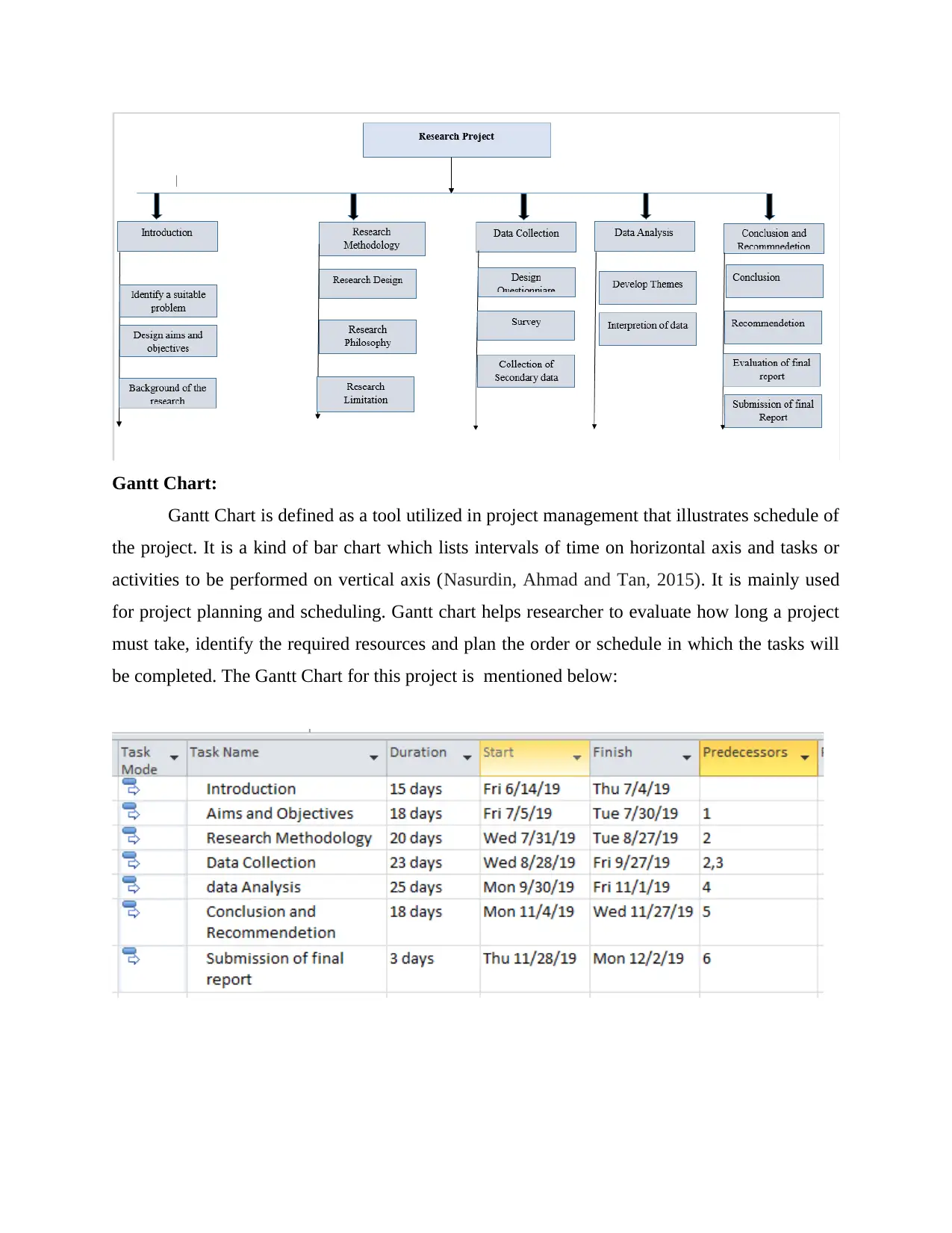
Gantt Chart:
Gantt Chart is defined as a tool utilized in project management that illustrates schedule of
the project. It is a kind of bar chart which lists intervals of time on horizontal axis and tasks or
activities to be performed on vertical axis (Nasurdin, Ahmad and Tan, 2015). It is mainly used
for project planning and scheduling. Gantt chart helps researcher to evaluate how long a project
must take, identify the required resources and plan the order or schedule in which the tasks will
be completed. The Gantt Chart for this project is mentioned below:
Gantt Chart is defined as a tool utilized in project management that illustrates schedule of
the project. It is a kind of bar chart which lists intervals of time on horizontal axis and tasks or
activities to be performed on vertical axis (Nasurdin, Ahmad and Tan, 2015). It is mainly used
for project planning and scheduling. Gantt chart helps researcher to evaluate how long a project
must take, identify the required resources and plan the order or schedule in which the tasks will
be completed. The Gantt Chart for this project is mentioned below:
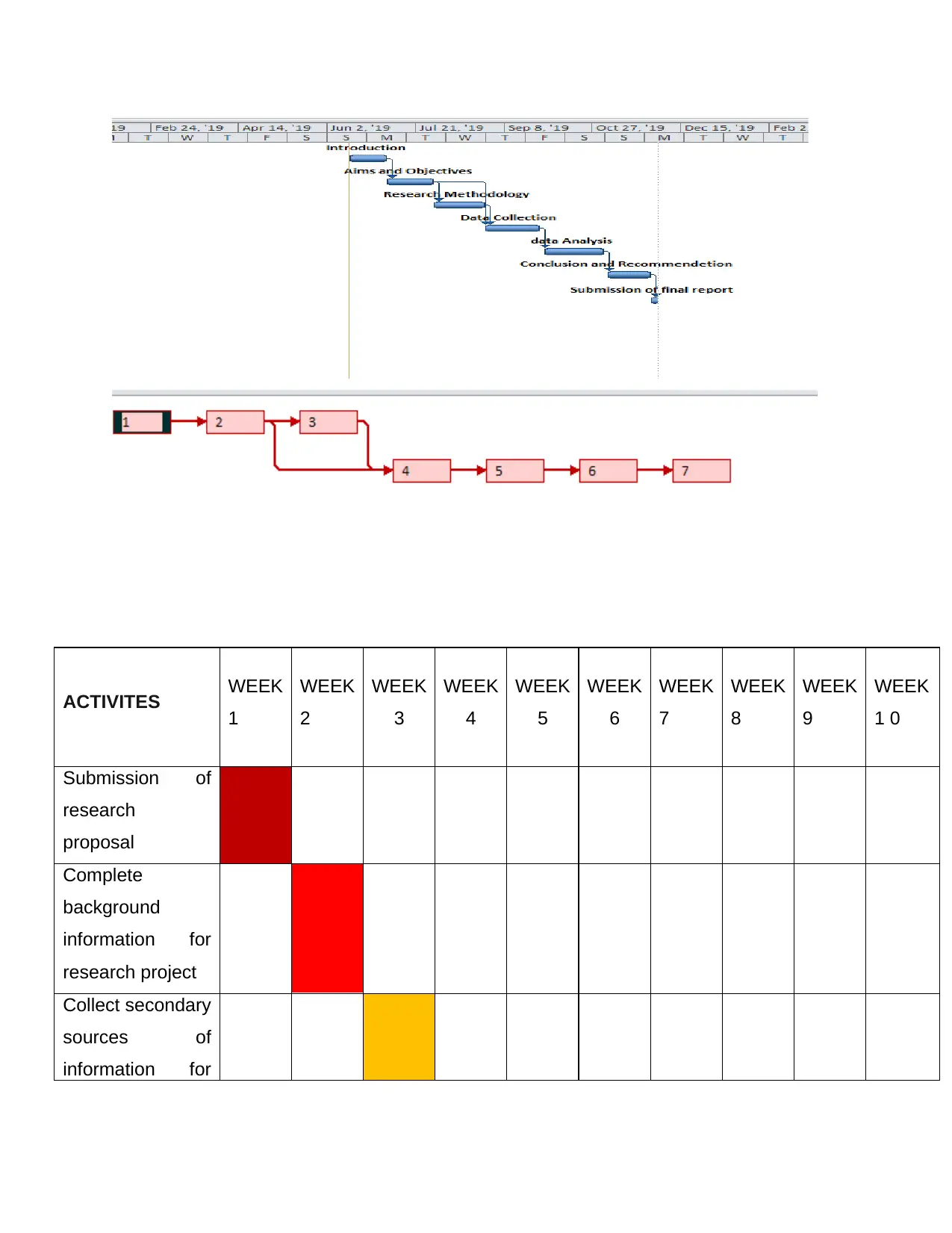
ACTIVITES WEEK
1
WEEK
2
WEEK
3
WEEK
4
WEEK
5
WEEK
6
WEEK
7
WEEK
8
WEEK
9
WEEK
1 0
Submission of
research
proposal
Complete
background
information for
research project
Collect secondary
sources of
information for
1
WEEK
2
WEEK
3
WEEK
4
WEEK
5
WEEK
6
WEEK
7
WEEK
8
WEEK
9
WEEK
1 0
Submission of
research
proposal
Complete
background
information for
research project
Collect secondary
sources of
information for
⊘ This is a preview!⊘
Do you want full access?
Subscribe today to unlock all pages.

Trusted by 1+ million students worldwide
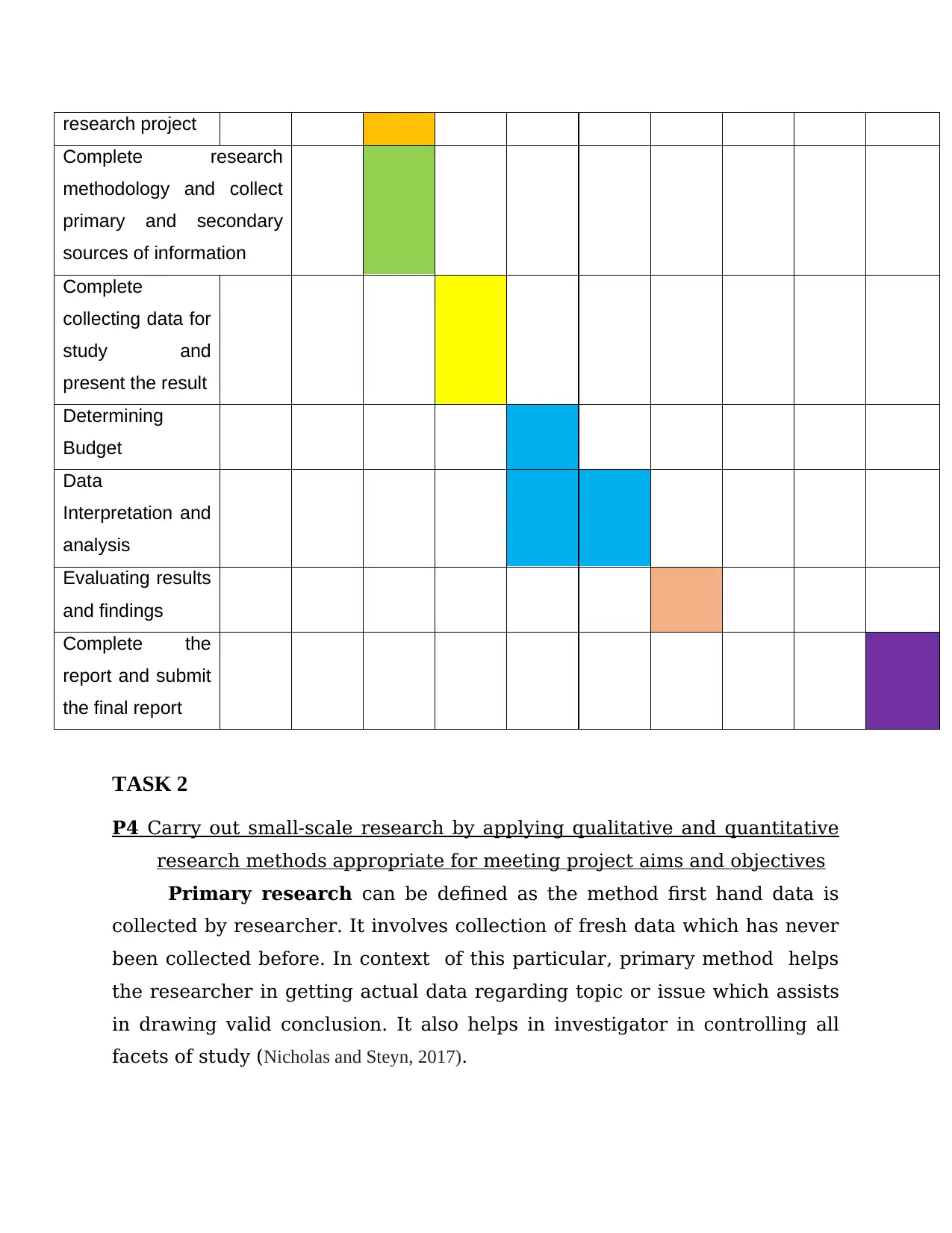
research project
Complete research
methodology and collect
primary and secondary
sources of information
Complete
collecting data for
study and
present the result
Determining
Budget
Data
Interpretation and
analysis
Evaluating results
and findings
Complete the
report and submit
the final report
TASK 2
P4 Carry out small-scale research by applying qualitative and quantitative
research methods appropriate for meeting project aims and objectives
Primary research can be defined as the method first hand data is
collected by researcher. It involves collection of fresh data which has never
been collected before. In context of this particular, primary method helps
the researcher in getting actual data regarding topic or issue which assists
in drawing valid conclusion. It also helps in investigator in controlling all
facets of study (Nicholas and Steyn, 2017).
Complete research
methodology and collect
primary and secondary
sources of information
Complete
collecting data for
study and
present the result
Determining
Budget
Data
Interpretation and
analysis
Evaluating results
and findings
Complete the
report and submit
the final report
TASK 2
P4 Carry out small-scale research by applying qualitative and quantitative
research methods appropriate for meeting project aims and objectives
Primary research can be defined as the method first hand data is
collected by researcher. It involves collection of fresh data which has never
been collected before. In context of this particular, primary method helps
the researcher in getting actual data regarding topic or issue which assists
in drawing valid conclusion. It also helps in investigator in controlling all
facets of study (Nicholas and Steyn, 2017).
Paraphrase This Document
Need a fresh take? Get an instant paraphrase of this document with our AI Paraphraser
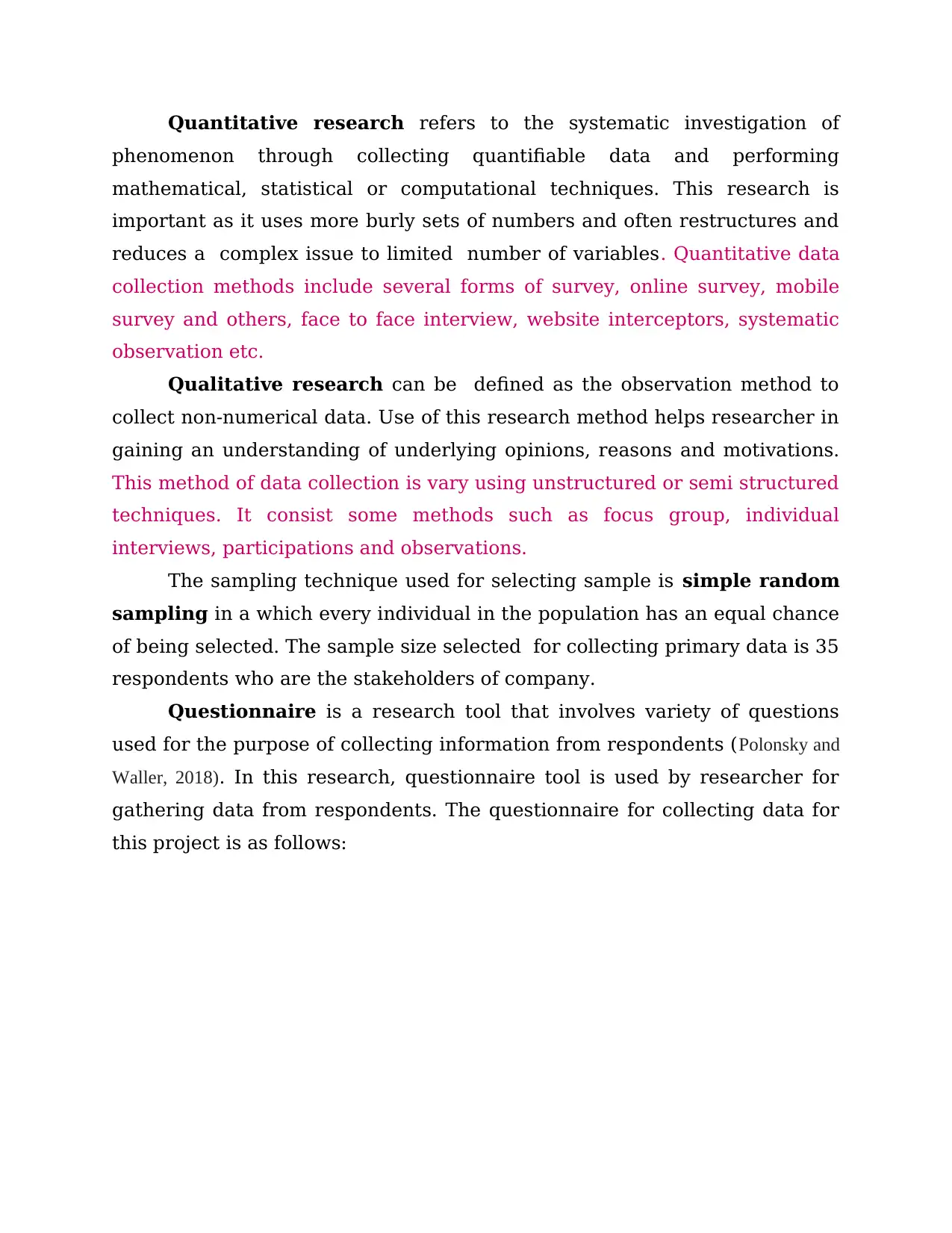
Quantitative research refers to the systematic investigation of
phenomenon through collecting quantifiable data and performing
mathematical, statistical or computational techniques. This research is
important as it uses more burly sets of numbers and often restructures and
reduces a complex issue to limited number of variables. Quantitative data
collection methods include several forms of survey, online survey, mobile
survey and others, face to face interview, website interceptors, systematic
observation etc.
Qualitative research can be defined as the observation method to
collect non-numerical data. Use of this research method helps researcher in
gaining an understanding of underlying opinions, reasons and motivations.
This method of data collection is vary using unstructured or semi structured
techniques. It consist some methods such as focus group, individual
interviews, participations and observations.
The sampling technique used for selecting sample is simple random
sampling in a which every individual in the population has an equal chance
of being selected. The sample size selected for collecting primary data is 35
respondents who are the stakeholders of company.
Questionnaire is a research tool that involves variety of questions
used for the purpose of collecting information from respondents (Polonsky and
Waller, 2018). In this research, questionnaire tool is used by researcher for
gathering data from respondents. The questionnaire for collecting data for
this project is as follows:
phenomenon through collecting quantifiable data and performing
mathematical, statistical or computational techniques. This research is
important as it uses more burly sets of numbers and often restructures and
reduces a complex issue to limited number of variables. Quantitative data
collection methods include several forms of survey, online survey, mobile
survey and others, face to face interview, website interceptors, systematic
observation etc.
Qualitative research can be defined as the observation method to
collect non-numerical data. Use of this research method helps researcher in
gaining an understanding of underlying opinions, reasons and motivations.
This method of data collection is vary using unstructured or semi structured
techniques. It consist some methods such as focus group, individual
interviews, participations and observations.
The sampling technique used for selecting sample is simple random
sampling in a which every individual in the population has an equal chance
of being selected. The sample size selected for collecting primary data is 35
respondents who are the stakeholders of company.
Questionnaire is a research tool that involves variety of questions
used for the purpose of collecting information from respondents (Polonsky and
Waller, 2018). In this research, questionnaire tool is used by researcher for
gathering data from respondents. The questionnaire for collecting data for
this project is as follows:
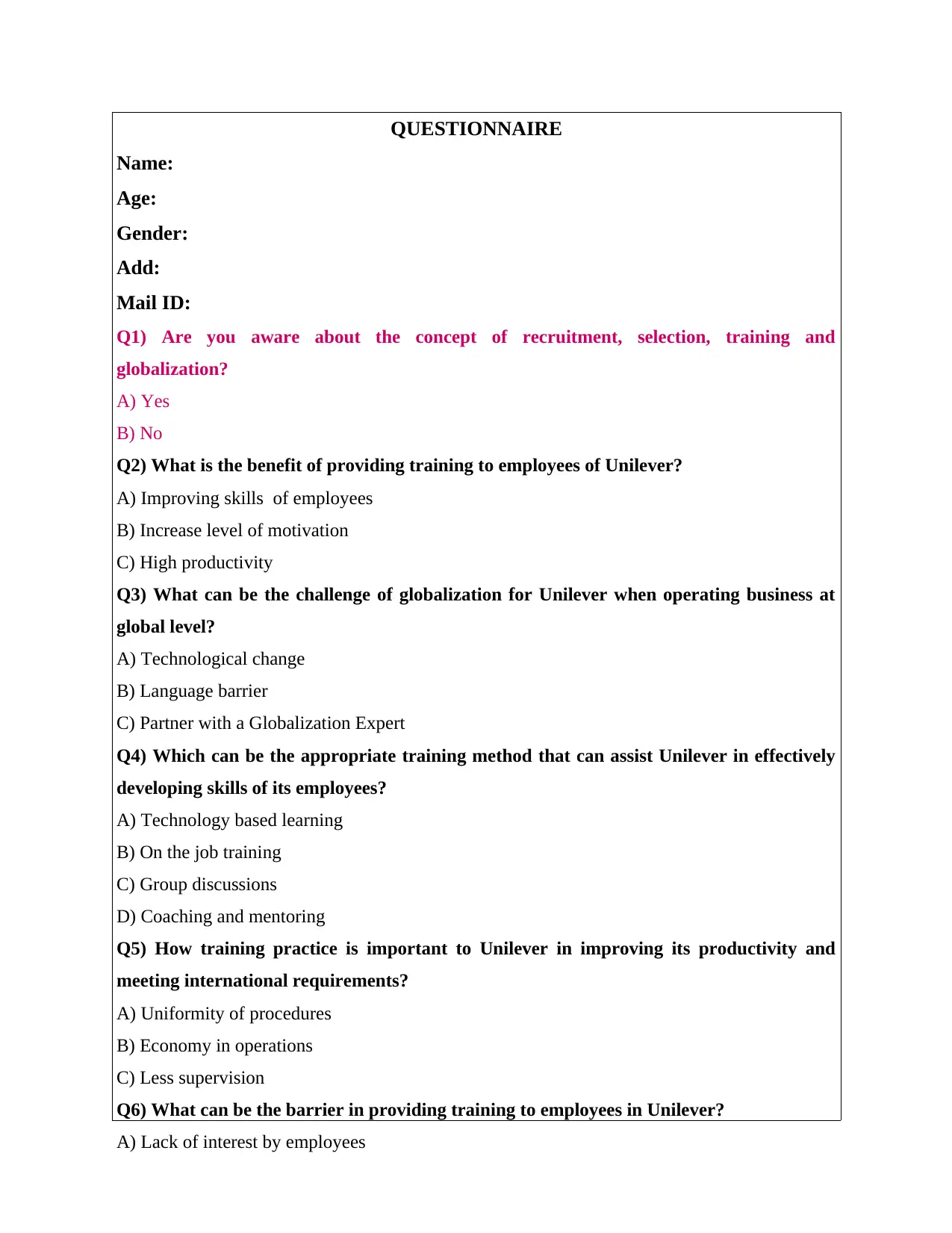
QUESTIONNAIRE
Name:
Age:
Gender:
Add:
Mail ID:
Q1) Are you aware about the concept of recruitment, selection, training and
globalization?
A) Yes
B) No
Q2) What is the benefit of providing training to employees of Unilever?
A) Improving skills of employees
B) Increase level of motivation
C) High productivity
Q3) What can be the challenge of globalization for Unilever when operating business at
global level?
A) Technological change
B) Language barrier
C) Partner with a Globalization Expert
Q4) Which can be the appropriate training method that can assist Unilever in effectively
developing skills of its employees?
A) Technology based learning
B) On the job training
C) Group discussions
D) Coaching and mentoring
Q5) How training practice is important to Unilever in improving its productivity and
meeting international requirements?
A) Uniformity of procedures
B) Economy in operations
C) Less supervision
Q6) What can be the barrier in providing training to employees in Unilever?
A) Lack of interest by employees
Name:
Age:
Gender:
Add:
Mail ID:
Q1) Are you aware about the concept of recruitment, selection, training and
globalization?
A) Yes
B) No
Q2) What is the benefit of providing training to employees of Unilever?
A) Improving skills of employees
B) Increase level of motivation
C) High productivity
Q3) What can be the challenge of globalization for Unilever when operating business at
global level?
A) Technological change
B) Language barrier
C) Partner with a Globalization Expert
Q4) Which can be the appropriate training method that can assist Unilever in effectively
developing skills of its employees?
A) Technology based learning
B) On the job training
C) Group discussions
D) Coaching and mentoring
Q5) How training practice is important to Unilever in improving its productivity and
meeting international requirements?
A) Uniformity of procedures
B) Economy in operations
C) Less supervision
Q6) What can be the barrier in providing training to employees in Unilever?
A) Lack of interest by employees
⊘ This is a preview!⊘
Do you want full access?
Subscribe today to unlock all pages.

Trusted by 1+ million students worldwide
1 out of 26
Related Documents
Your All-in-One AI-Powered Toolkit for Academic Success.
+13062052269
info@desklib.com
Available 24*7 on WhatsApp / Email
![[object Object]](/_next/static/media/star-bottom.7253800d.svg)
Unlock your academic potential
Copyright © 2020–2025 A2Z Services. All Rights Reserved. Developed and managed by ZUCOL.



